Consultation launched to identify infrastructure which can be utilised in UK’s Shared Rural Network
The Department for Digital, Culture, Media and Sport (DCMS) has today launched a new consultation to identify any existing infrastructure that may be used to support its investment in the Shared Rural Network. The infrastructure identified will be in areas where investment is used to reduce “Total Not Spots” (TNS)—those hard-to-reach areas where there is currently no coverage from any operator.
This could be through ownership of specific telecommunications infrastructure or where there are plans to build such infrastructure, shown in the map below.
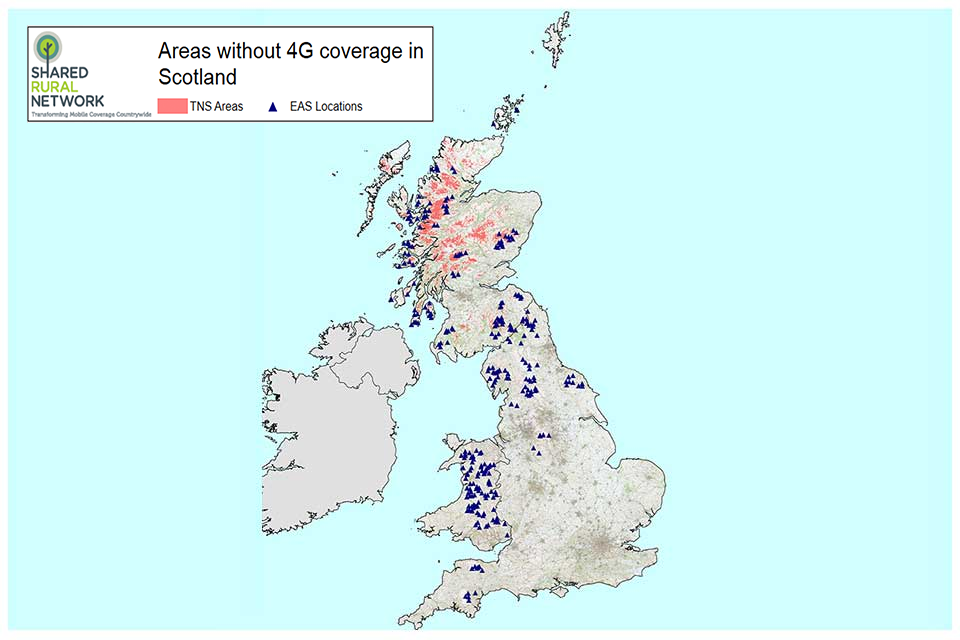
The Shared Rural Network (SRN) is a £1 billion government deal with the UK’s four Mobile Network Operators (MNOs) EE, O2, Three and Vodafone, that will see both public and private investment in a network of new and existing phone masts closing not-spots and levelling up connectivity across every corner of the UK. It will bring an extra 280,000 premises and an additional 16,000 km of UK roads in range of a 4G signal - increasing total geographic 4G coverage to 95 per cent of the UK by the end of 2025.
SRN: UK Coverage Forecast Improvements in the UK
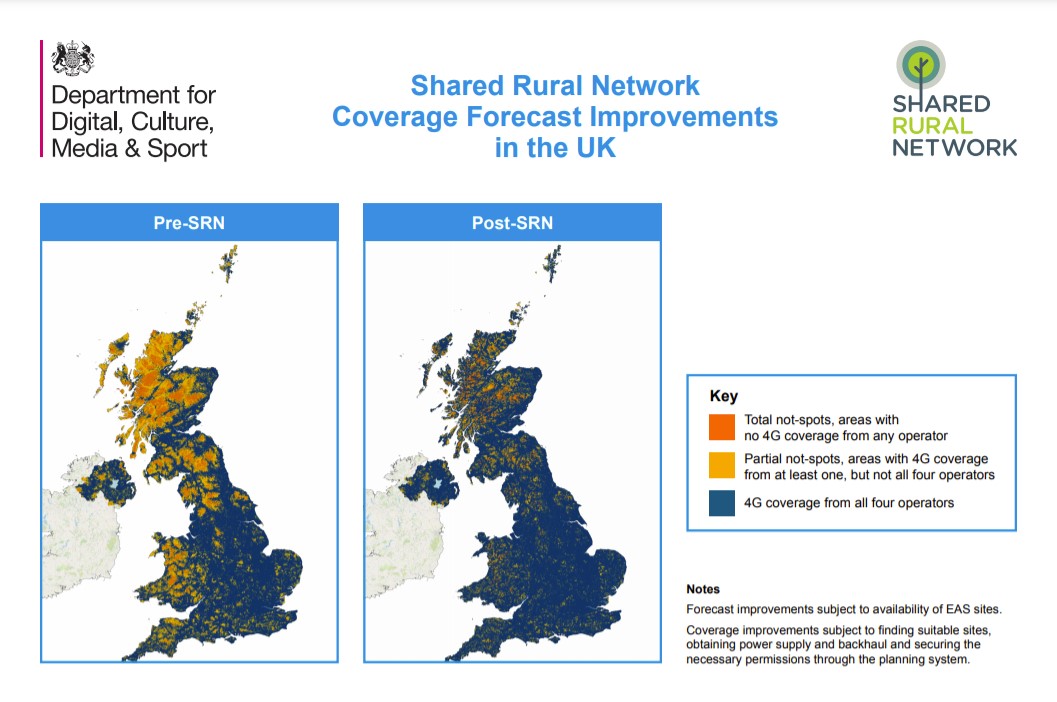
As a result of the Shared Rural Network, 4G in all four home nations of the UK coverage will increase as follows:
|
|
4G Coverage from at least one MNO pre-SRN |
4G Coverage from at least one MNO by the end of programme |
4G coverage from all MNOs pre-SRN |
4G coverage from all MNOs by the end of the programme |
|
Overall |
91% |
95% |
69% |
84% |
|
England |
97% |
98% |
84% |
90% |
|
Scotland |
81% |
91% |
44% |
74% |
|
Wales |
90% |
95% |
60% |
80% |
|
Northern Ireland |
97% |
98% |
79% |
85% |
SRN: Scotland Coverage Forecast Improvements
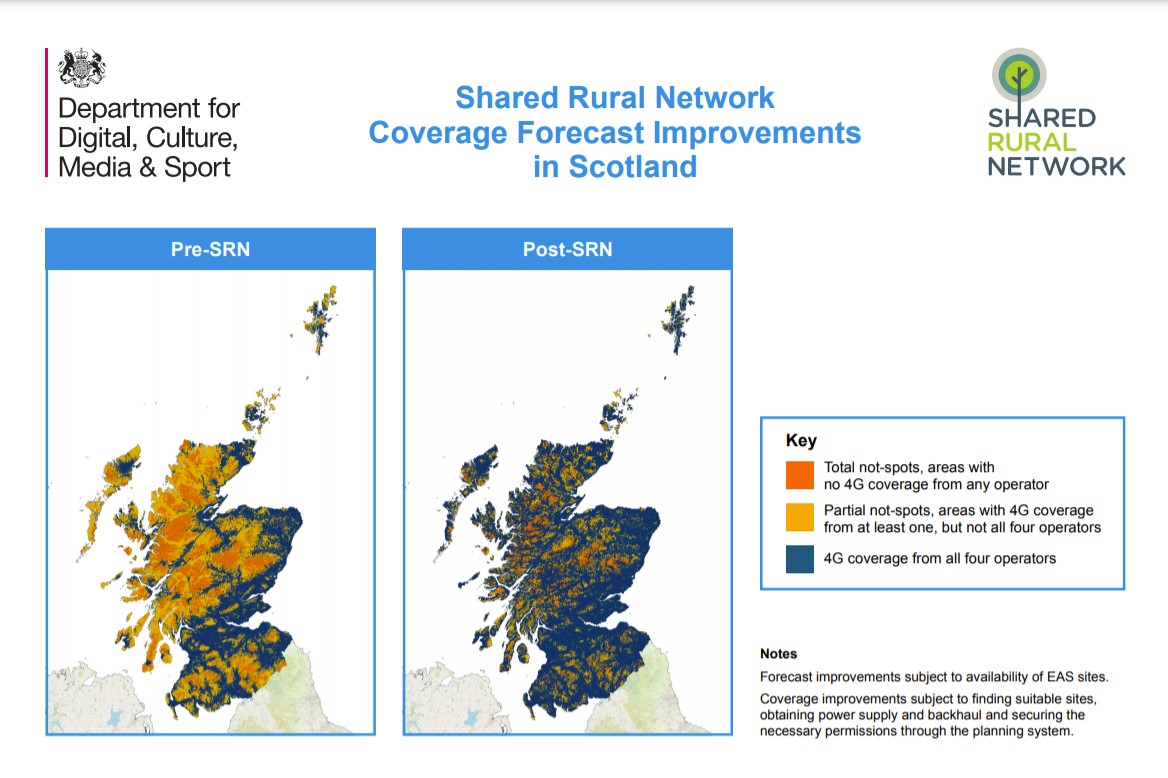
Scotland :
|
|
Coverage from all MNOs |
Coverage from at least one MNO |
||
|
Electoral Region |
Pre-SRN |
Forecast post-SRN |
Pre-SRN |
Forecast post-SRN |
|
Central Scotland |
87% |
92% |
99% |
99% |
|
Highlands and Islands |
26% |
68% |
73% |
91% |
|
Lothian |
88% |
94% |
99% |
99% |
|
Mid Scotland and Fife |
53% |
78% |
80% |
93% |
|
North East Scotland |
59% |
79% |
86% |
94% |
|
South Scotland |
55% |
81% |
88% |
97% |
|
West Scotland |
59% |
82% |
91% |
98% |
SRN: Wales Forecast Coverage Improvements
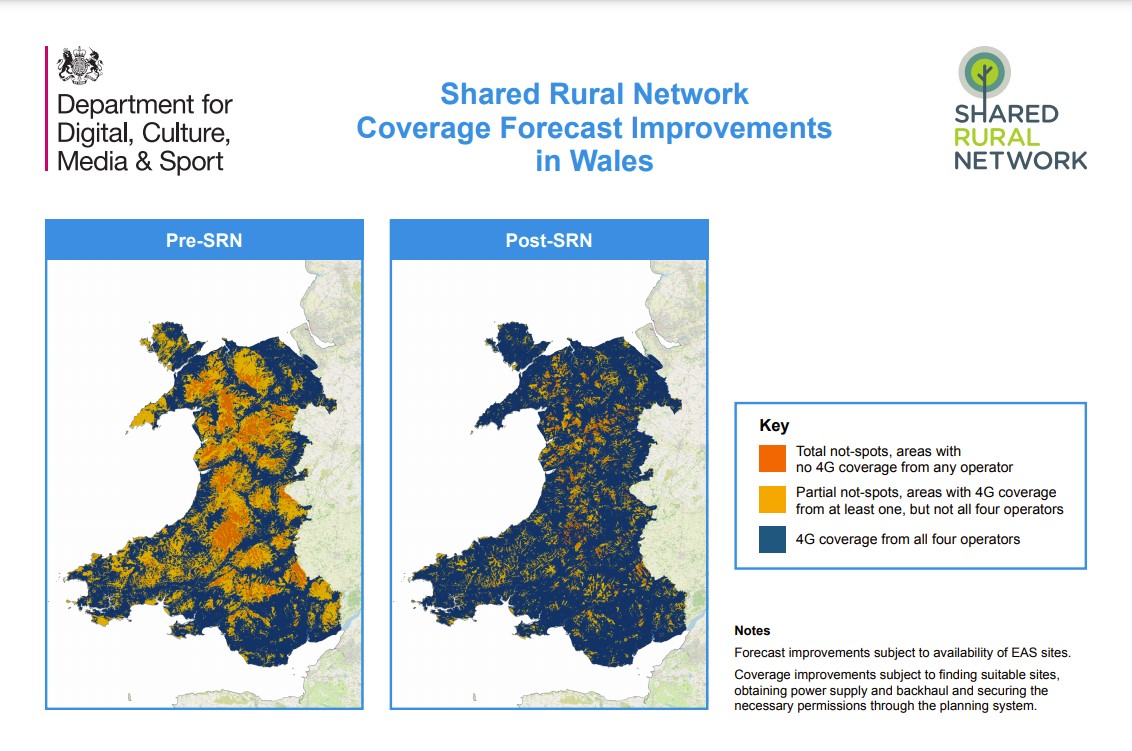
Wales
|
|
Coverage from all MNOs |
Coverage from at least one MNO |
||
|
Senedd Region |
Pre-SRN |
Forecast post-SRN |
Pre-SRN |
Forecast post-SRN |
|
Mid and West Wales |
51% |
78% |
86% |
97% |
|
North Wales |
63% |
83% |
93% |
98% |
|
South Wales Central |
82% |
90% |
98% |
99% |
|
South Wales East |
71% |
89% |
95% |
99% |
|
South Wales West |
79% |
88% |
97% |
99% |
SRN: Northern Ireland Coverage Forecast Improvements
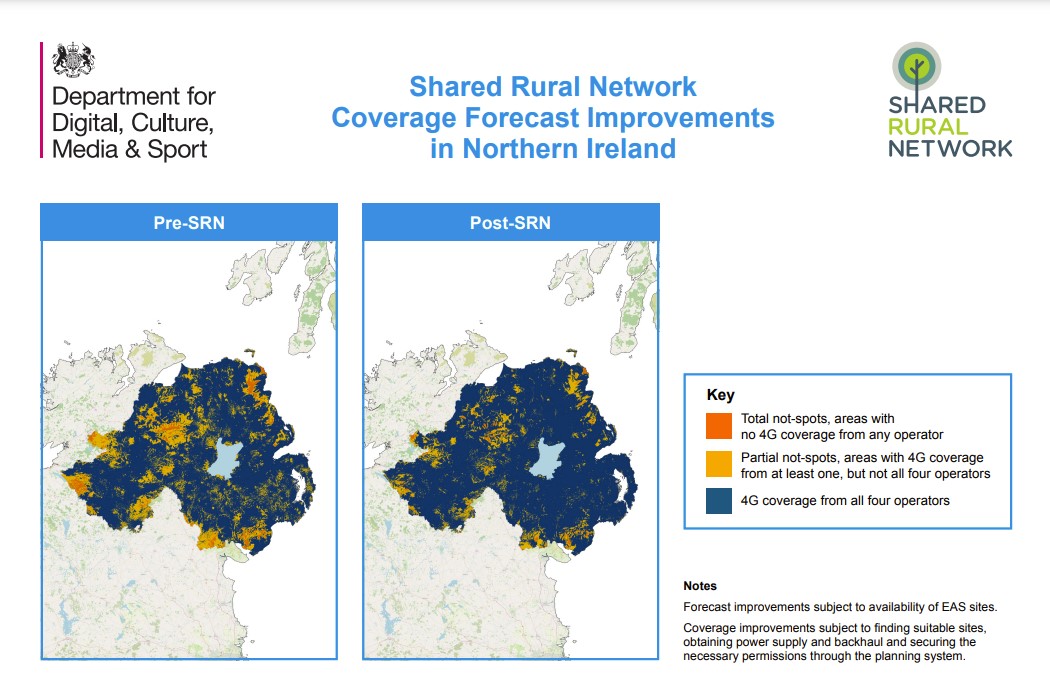
Northern Ireland
|
|
Coverage from all MNOs |
Coverage from at least one MNO |
||
|
Region (Local Authority) |
Pre-SRN |
Forecast post-SRN |
Pre-SRN |
Forecast post-SRN |
|
Antrim and Newtownabbey |
86% |
94% |
99% |
99% |
|
Ards and North Down |
85% |
99% |
99% |
99% |
|
Armagh City, Banbridge and Cra |
82% |
93% |
99% |
99% |
|
Causeway Coast and Glens |
77% |
87% |
96% |
99% |
|
Derry City and Strabane |
61% |
76% |
92% |
97% |
|
Fermanagh and Omagh |
71% |
79% |
96% |
98% |
|
Lisburn and Castlereagh |
88% |
96% |
99% |
99% |
|
Mid Ulster |
73% |
87% |
99% |
99% |
|
Mid and East Antrim |
81% |
88% |
98% |
98% |
|
Newry, Mourne and Down |
67% |
80% |
94% |
98% |
SRN: England Coverage Forecast Improvements
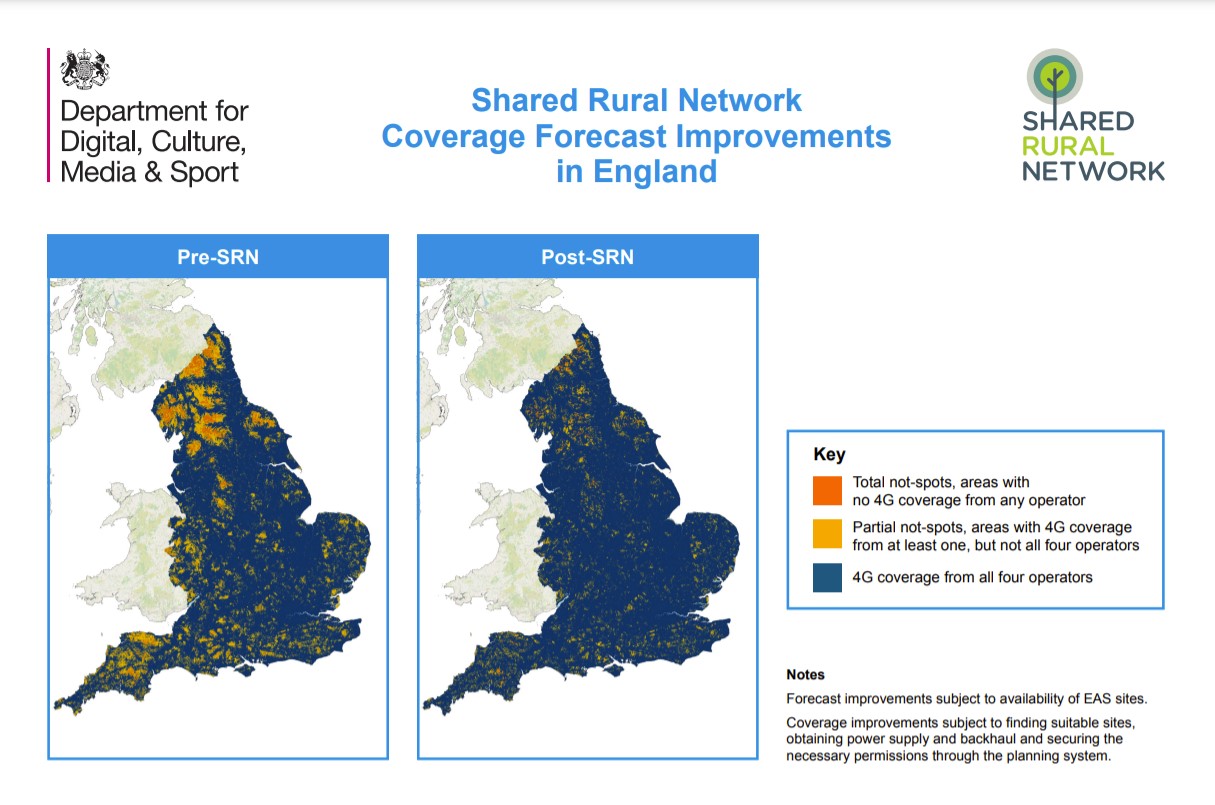
England
|
|
Coverage from all MNOs |
Coverage from at least one MNO |
||
|
Region |
Pre-SRN |
Forecast post-SRN |
Pre-SRN |
Forecast post-SRN |
|
East Midlands |
90% |
94% |
99% |
99% |
|
East of England |
90% |
93% |
99% |
99% |
|
North East |
68% |
86% |
91% |
98% |
|
North West |
73% |
88% |
94% |
98% |
|
South East |
85% |
91% |
99% |
99% |
|
South West |
75% |
87% |
97% |
99% |
|
West Midlands |
78% |
92% |
99% |
99% |
|
Yorkshire and The Humber |
81% |
90% |
95% |
99% |
Find out more about the consultation here. The deadline for submission is 27 July 2021.
Project Gigabit update: Wales, Scotland and Northern Ireland set to benefit
The UK government has also announced its next steps in the £5 billion Project Gigabit programme. Designed to deploy “Outside In” with the hard to reach and rural areas upgrading to gigabit-capable broadband speeds via public investment, up to 234,000 hard-to-reach Welsh homes and businesses have been announced for deployment. They include rural towns and villages in Carmarthenshire, Ceredigion, Conwy, Denbighshire, Flintshire, Gwynedd, the Isle of Anglesey, Pembrokeshire and Powys.
The government will set out the timetable for the delivery of these connections once it has agreed the procurement process with the Welsh Government.
Further announcements include an additional £24 million to fund the rollout of gigabit broadband in ten local authority areas in Northern Ireland. The Full Fibre Northern Ireland (FFNI) scheme will see 969 hospitals, GP surgeries, ambulance and fire stations, community and leisure centres, council offices and other public buildings connected to gigabit-capable networks.
For Scotland, the Scottish Government has confirmed it can continue to provide up to £5,000 extra funding to top-up the Gigabit Broadband Voucher Scheme. This is in addition to the £1,500 available to rural homes and £3,500 available to rural small to medium-sized businesses. Work continues by the UK and Scottish Governments on gigabit deployment through their Reaching 100% (R100) programme. The scope of the final R100 contract will be confirmed in the Summer.





